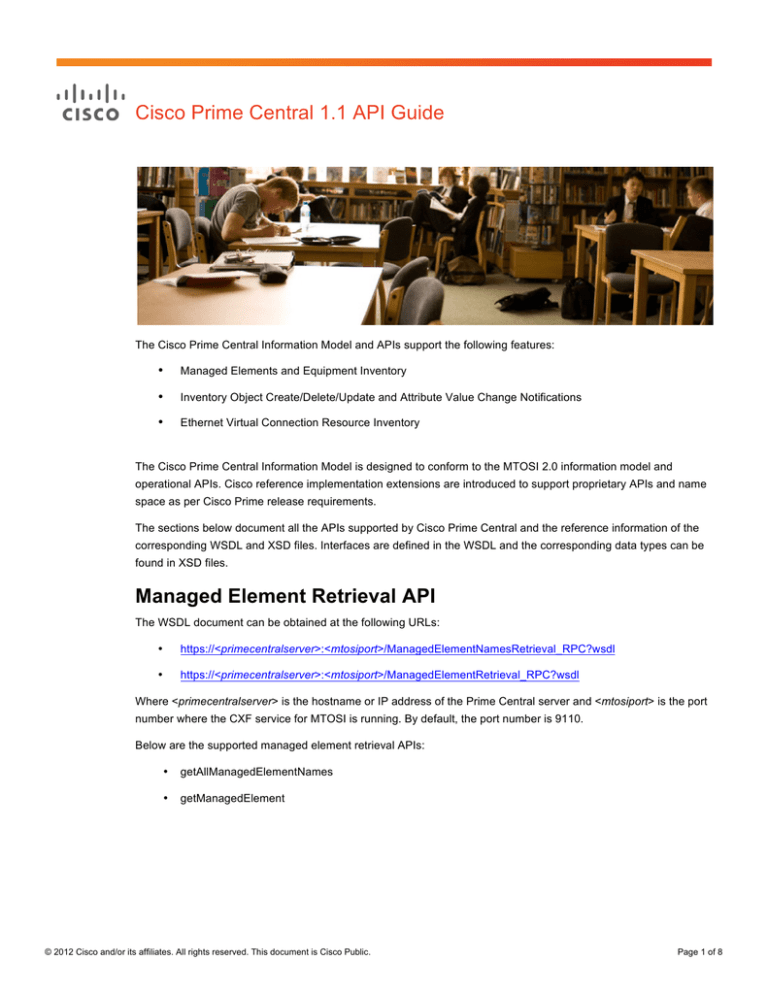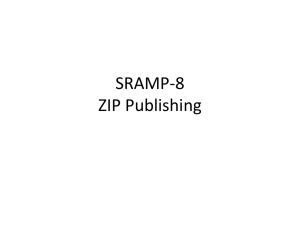
Cisco Prime Central 1.1 API Guide
The Cisco Prime Central Information Model and APIs support the following features:
•
Managed Elements and Equipment Inventory
•
Inventory Object Create/Delete/Update and Attribute Value Change Notifications
•
Ethernet Virtual Connection Resource Inventory
The Cisco Prime Central Information Model is designed to conform to the MTOSI 2.0 information model and
operational APIs. Cisco reference implementation extensions are introduced to support proprietary APIs and name
space as per Cisco Prime release requirements.
The sections below document all the APIs supported by Cisco Prime Central and the reference information of the
corresponding WSDL and XSD files. Interfaces are defined in the WSDL and the corresponding data types can be
found in XSD files.
Managed Element Retrieval API
The WSDL document can be obtained at the following URLs:
•
https://<primecentralserver>:<mtosiport>/ManagedElementNamesRetrieval_RPC?wsdl
•
https://<primecentralserver>:<mtosiport>/ManagedElementRetrieval_RPC?wsdl
Where <primecentralserver> is the hostname or IP address of the Prime Central server and <mtosiport> is the port
number where the CXF service for MTOSI is running. By default, the port number is 9110.
Below are the supported managed element retrieval APIs:
•
getAllManagedElementNames
•
getManagedElement
© 2012 Cisco and/or its affiliates. All rights reserved. This document is Cisco Public.
Page 1 of 8
Equipment Retrieval APIs
The WSDL document can be obtained at the following URL:
https://<primecentralserver>:<mtosiport>/EquipmentInventoryRetrieval_RPC?wsdl
Where <primecentralserver> is the hostname or IP address of the Prime Central server and <mtosiport> is the port
number where the CXF service for MTOSI is running. By default, the port number is 9110.
Below are the supported APIs:
•
getAllEquipment
•
getEquipment
•
getContainedEquipment
Physical Termination Point Retrieval APIs
The WSDL document can be obtained at the following URL:
https://<primecentralserver>:<mtosiport>/TerminationPointRetrieval_RPC?wsdl
Where <primecentralserver> is the hostname or IP address of the Prime Central server and <mtosiport> is the port
number where the CXF service for MTOSI is running. By default, the port number is 9110. The following API is
supported: getAllSupportedPhysicalTermiminationPoints
Physical Inventory Notifications
The Integration Layer (IL) will expose interfaces for enabling clients of the IL to register and receive notifications of
interest.
The currently supported IL interfaces consist of the following:
•
WS-SOAP interface that supports MTOSI-conformant operations
•
JMS interface that supports the same MTOSI operations using serialized Java objects
The IL notification framework should be based on the above interfaces. This entails the following:
•
Support the MTOSI-style notification topic registration pattern for the WS-SOAP interface:
•
SubscribeResponse subscribe(
Holder<Header> mtopHeader,
SubscribeRequest mtopBody
) throws SubscribeException;
•
UnsubscribeResponse unsubscribe(
Holder<Header> mtopHeader,
UnsubscribeRequest mtopBody
) throws UnsubscribeException;
© 2012 Cisco and/or its affiliates. All rights reserved. This document is Cisco Public.
Page 2 of 8
The subscribe request specifies the following:
•
Consumer - URI
•
Topic - The string indicating the classification of events of interest
•
Selector - Notification Filter
The subscribe response contains a subscriptionID.
The unsubscribe request requires the subscriptionID(s) and topic(s) provided at the time of registration.
The Cisco Prime Central information model supports standard JMS topic subscription for JMS interfaces.
On the notification consumer side, each client type (WS-SOAP or JMS) is expected to support a slightly different
flow:
WS-SOAP clients must:
•
Expose the NotificationConsumer API as defined by the NotificationConsumerHttp.wsdl and documented
in the MTOSI R2.0 Framework DDP.
•
Use the Subscribe operation to register for notifications.
JMS clients consume POJOs with the following format:
ArrayList<Object> consisting of the following in this order:
1.
com.cisco.prime.esb.fmw.api.Header
2.
org.tmforum.mtop.fmw.xsd.notmsg.v1.Notify
For Prime Central 1.1, the supported notification types include:
•
Object Creation Notification
•
Object Deletion Notification
•
Attribute Value Change Notification
These notifications are supported across the following objects:
•
Managed Element
•
Equipment Holder
•
Equipment
•
Physical Termination Point
Common Inventory is the primary consumer of notifications within the Prime Suite, because it maintains
synchronization with the state of live devices. It is anticipated that Common Inventory will consume notifications
from the JMS interface. Other consumers are expected to be Fulfillment (JMS) and the Prime Suite NBI users
(SOAP).
© 2012 Cisco and/or its affiliates. All rights reserved. This document is Cisco Public.
Page 3 of 8
This table contains the APIs supported for managed elements, equipment inventory and notication of the relevant
entities and attributes. This table also lists notification-related APIs on inventory object and attribute value changes.
API
Response
Request
Description
getAllManaged getAllManagedElem getAllManagedEle
ElementNames entNamesResponse mentNamesReque
( ... )
st
A list of managed
element names.
Returns all managed element names. This is a
proprietory API to facilitate the getManagedElement
API for a specific managed element retrieval.
getManagedEl
ement( ... )
Returns a requested managed element instance. See
the corresponding wsdl/xsd files for more details:
getManagedElemen
tResponse
A specific managed
element instance.
getManagedEleme
ntRequest
A list of RDN
consisting of
MD/ME namevalue pairs.
•
•
ManageResourceInventory/IIS/wsdl/ManagedEle
mentRetrieval/ManagedElementRetrievalHttp.wsd
l
ManageResourceInventory/IIS/xsd/ManagedElem
entRetrievalMessages.xsd
Required ME attribute extensions are defined in:
NetworkResourceFulfillment/IIS/xsd/Cisco_ME_EQ_In
ventory.xsd
getAllEquipme
nt(...)
getAllEquipmentRes getAllEquipmentRe Returns a list of equipment and equipment holders.
ponse
quest
See the corresponding wsdl/xsd files for more details:
Name
of
the
ME
or
A list of all of the
•
ManageResourceInventory/IIS/wsdl/EquipmentInv
equipment holder
equipment and
entoryRetrieval/EquipmentInventoryRetrievalHttp.
for which to
equipment holders
wsdl
retrieve
contained
contained in a
•
ManageResourceInventory/IIS/xsd/EquipmentInv
equipment
and
managed element
entoryRetrievalMessages.xsd
equipment holders.
or equipment
holders.
© 2012 Cisco and/or its affiliates. All rights reserved. This document is Cisco Public.
Required equipment attribute extensions are defined
in:
NetworkResourceFulfillment/IIS/xsd/Cisco_ME_EQ_In
ventory.xsd
Page 4 of 8
getContainedEqui
pment(...)
getAllEquipmentResp
onse
A list of all of the
equipment and
equipment holders
contained in the
equipment holders.
getAllEquipmentRequ
est
Name of the
equipment holder to
retrieve the next-level
contained equipment
and equipment
holders.
Returns the next-level contained Equipment
Holder and Equipment list. See the
corresponding wsdl/xsd files for more details:
•
•
ManageResourceInventory/IIS/wsdl/Equip
mentInventoryRetrieval/EquipmentInvento
ryRetrievalHttp.wsdl
ManageResourceInventory/IIS/xsd/Equip
mentInventoryRetrievalMessages.xsd
Equipment Attribute Extension as per
requirement are defined in:
NetworkResourceFulfillment/IIS/xsd/Cisco_ME
_EQ_Inventory.xsd
getAllSupportedP
hysicalTerminatio
nPoints( ... )
getAllSupportedPhysic
alTerminationPointsR
esponse
A list of physical
termination endpoints
(PTP) of the specified
equipment.
getAllSupportedPhysi
calTerminationPoints
Request
A list of RDNs that
specify the containing
equipment:
MD/ME/EH[/EH/EH]/
EQ.
Returns a list PTPs. See the corresponding
wsdl/xsd files for more details:
•
•
ManageResourceInventory/IIS/wsdl/Termi
nationPointRetrieval/TerminationPointRetr
ievalMessages.wsdl
ManageResourceInventory/IIS/xsd/Termin
ationPointRetrievalMessages.xsd
Required PTP attribute extensions are defined
in:
NetworkResourceFulfillment/IIS/xsd/Cisco_ME
_EQ_Inventory.xsd
subscribe(...)
subscribeResponse
A unique subscription
identifier is returned to
the client OS to be
used when invoking
the unsubscribe() for
the given topic. Note
that it must uniquely
identify the request
signature by its three
elements:
consumerEPR, topic,
and selector.
subscribeRequest
This operation allows
the client to subscribe
for notifications.
© 2012 Cisco and/or its affiliates. All rights reserved. This document is Cisco Public.
The subscribe operation used to receive
subscriptions from consumers. See the
corresponding wsdl/xsd files for more details:
•
•
Framework/IIS/wsdl/NotificationProducer/
NotificationProducerHttp.wsdl
Framework/IIS/xsd/NotificationMessages.
xsd
Page 5 of 8
unsubscribe( unsubscribeResp
...)
onse
Response
message
structure of the
unsubscribe
operation. Note
that it is an empty
payload. Failure
should be
handled as an
exception.
unsubscribeReq
uest
This operation
allows the client
to unsubscribe
from a previous
subscribed
notification
channel.
The unsubscribe operation used to receive subscription
cancellations from consumers. See the corresponding
wsdl/xsd files for more details:
notify(...)
Not applicable.
One-way (notification) message structure of the notify
operation. This operation allows event notification to a client
OS for the following event types:
Not applicable.
•
•
Framework/IIS/wsdl/NotificationProducer/NotificationProd
ucerHttp.wsdl
Framework/IIS/xsd/NotificationMessages.xsd
•
•
•
AttributeValueChangeType
ObjectCreationType
ObjectDeletionType
See the corresponding wsdl/xsd files for more details:
Framework/IIS/wsdl/NotificationProducer/NotificationProducer
Http.wsdl
Ethernet Virtual Connection Resource Inventory APIs
The WSDL document can be obtained at the following URL: https://<primecentralserver>:<mtosiport>/
FlowDomainFragmentRetrieval_RPC?wsdl
Where <primecentralserver> is the hostname or IP address of the Prime Central server and <mtosiport> is the port
number where the CXF service for MTOSI is running. By default, the port number is 9110.
This WSDL supports the following APIs:
•
getFlowDomainFragment
•
getFlowDomainFragmentRoute
•
getAllFlowDomainFragmentNames
© 2012 Cisco and/or its affiliates. All rights reserved. This document is Cisco Public.
Page 6 of 8
For details about the interfaces and data types, see:
•
•
ManagedResourceInventory/FlowDomainFragmentRetrieval wsdl file
ManagedResourceInventory/FlowDomainFragmentRetrieval xsd file
Shortcut tip: Pressi
Close
Cancel
What are you worki
Enter your status (1
Update
Cancel
2097152
en_GB
/s/en/2154/23/_
Last update:
The following table shows the APIs to retrieve Ethernet virtual connections (EVCs), plus MTOSI extension points
and extensions. Supported service topologies include point-to-point, multipoint-to-multipoint, and point-to-multipoint
(E-tree).
API
Function
getFlowDomainFragment(… Retrieves flow domain
)
fragment entities, CTP
entities, and the matrix flow
domain fragment reference
list. If successful, this
operation returns EVC,
service parameters, EFP
(and its parameters), and the
forwarding reference list.
Extension Point and
Extension
Extension points:
1.
2.
3.
FlowDomainFragmentType >
LayeredParametersType > LayerRateType
FlowDomainFragmentType >
LayeredParametersType >
vendorExtensions
FlowDomainFragmentType >
TerminationPointDataListType >
TerminationPointDataType >
LayeredParametersType >
vendorExtensions
Extensions are defined in:
•
NetworkResourcesBasic/IIS/xsd/LayerRates
.xsd
•
NetworkResourcesBasic/IIS/xsd/Cisco_CE_
LayeredParam.xsd
getFlowDomainFragmentRo Retrieves the matrix flow
ute(…)
domain fragment. If
successful, this operation
returns EoMPLS forwarding
entities, including Ethernet
pseudowire edge instances
or cross-connects, and VFI.
Extension points:
1. FlowDomainFragmentRouteType ->
MatrixFlowDomainFragmentType >LayeredParameterType>vendorExtensions
2. FlowDomainFragmentRouteType ->
MatrixFlowDomainFragmentType>vendorExtensions
Extensions are defined in:
NetworkResourcesBasic/IIS/xsd/Cisco_CE_
LayeredParam.xsd
© 2012 Cisco and/or its affiliates. All rights reserved. This document is Cisco Public.
Page 7 of 8
getAllFlowDomainFragment(…) Retrieves names of all the managed
flow domain fragments. If successful,
this operation returns all Ethernet
connection names.
© 2012 Cisco and/or its affiliates. All rights reserved. This document is Cisco Public.
This is a proprietory API introduced to
facilitate the client to perform
subsequent retrieval of a named
Ethernet connection.
Page 8 of 8





